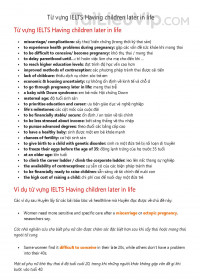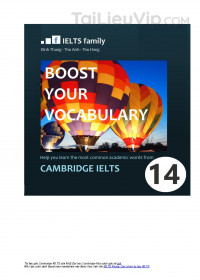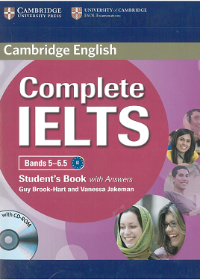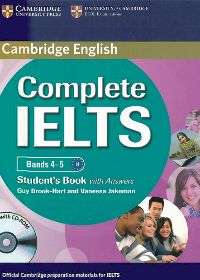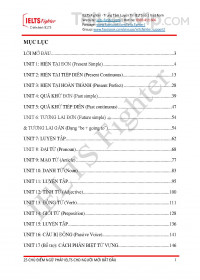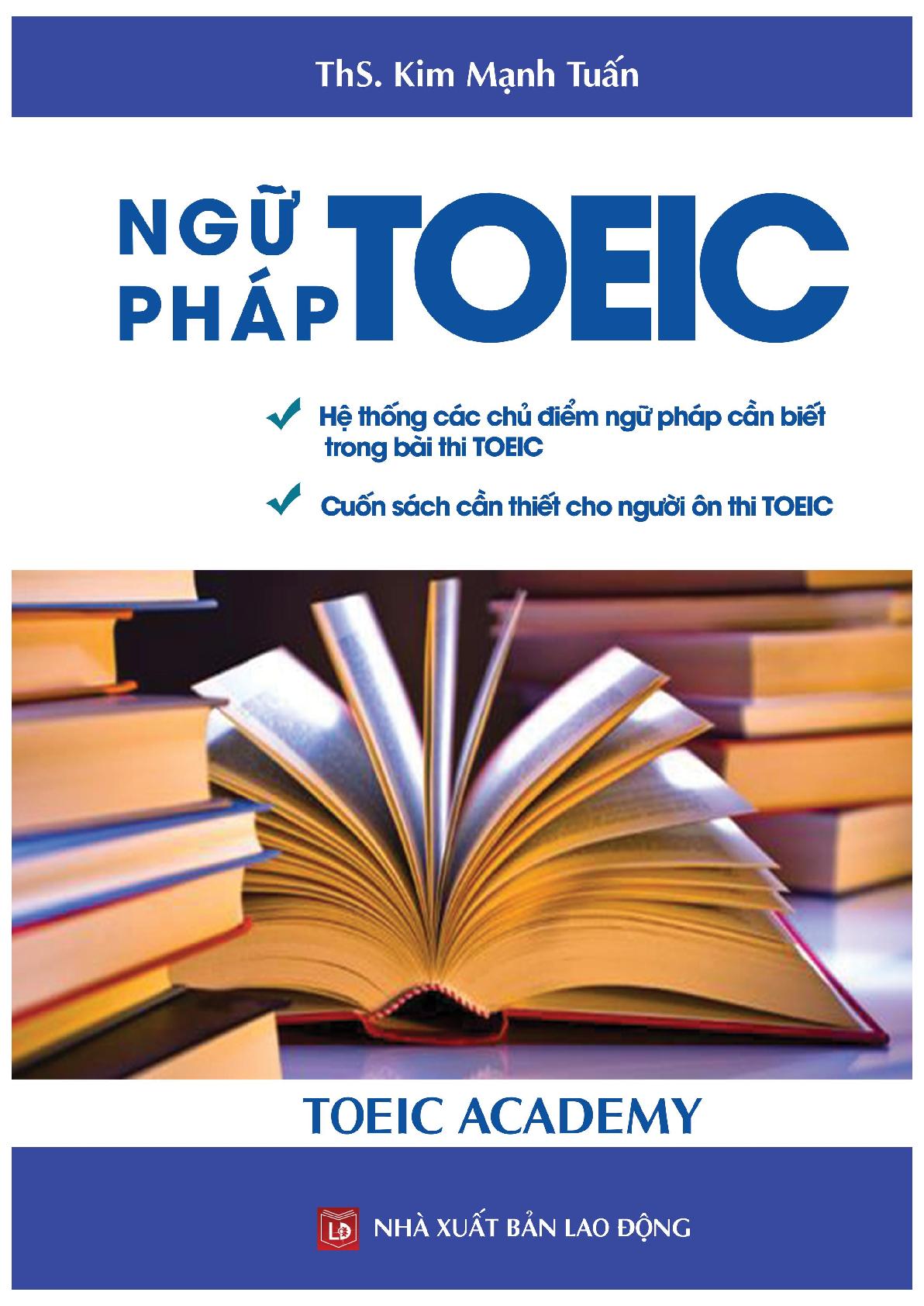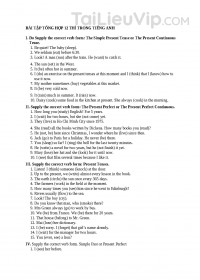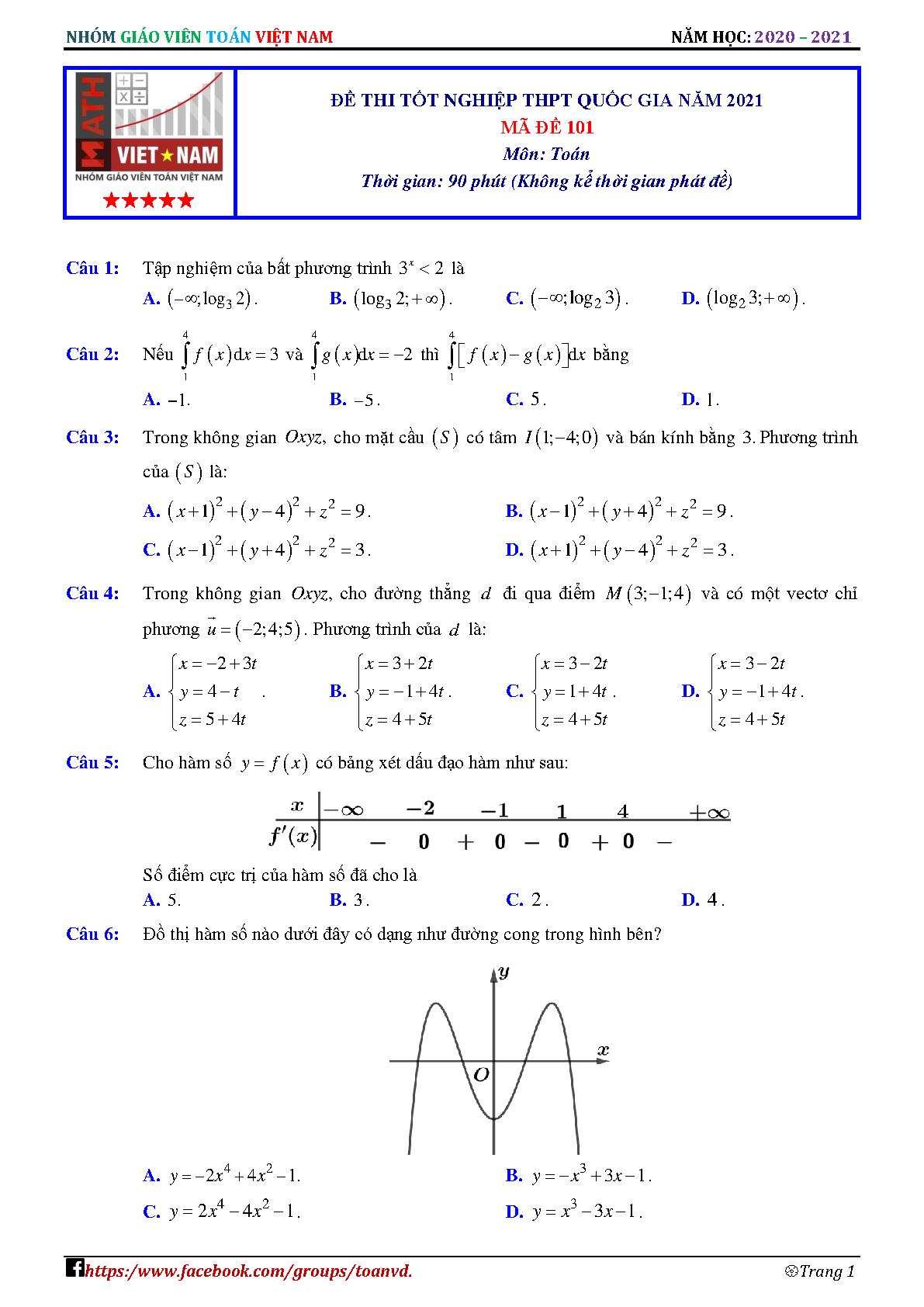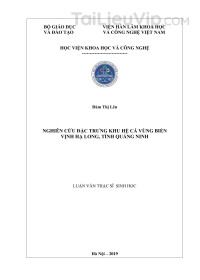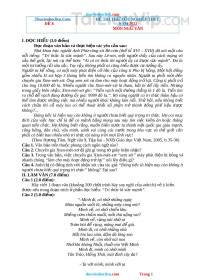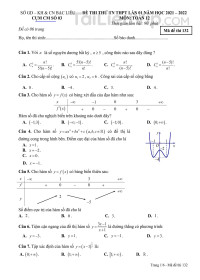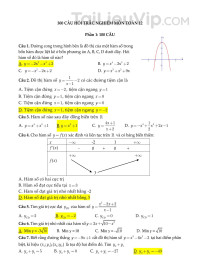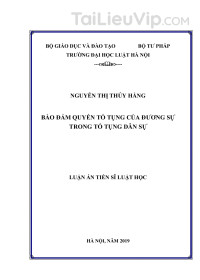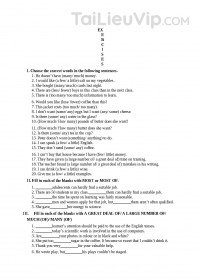Download sách Barron's Writing for the IELTS
1,029 16

Tải về máy để xem đầy đủ hơn, bản xem trước là bản PDF
Tags: #sách ielts#ielts#Barron's Writing
Mô tả chi tiết
1 Task Achievement/Task Response
Academic Writing Task 1: Charts, Graphs, Tables
Step 1: Plan
Address the Task
Determine the Topic
Make Notes About Comparisons
Make Notes About Details
Step 2: Write
Write the Introduction
Write the Paragraphs
Write the Conclusion
Step 3: Revise
Use the Revision Checklist
Academic Writing Task 1: Process Diagrams
Step 1: Plan
Address the Task
Determine the Topic
Make Notes About Details
Step 2: Write
Write the Introduction
Write the Body of the Essay
Step 3: Revise
Use the Revision Checklist
General Training Writing Task 1: Letter
Step l: Plan
Address the Task
Determine the Topic
Make Notes About Main Ideas
Make Notes About Details
Step 2: Write
Write the Greeting
Write the Introduction
Write the Paragraphs
Write the Conclusion
Write the Signature
Step 3: Revise
Use the Revision Checklist
Academic/General Training Writing Task 2: Personal Opinion ..
Step 1: Plan
Address the Task
Write a Thesis Statement.
Make Notes About Main Ideas and Supporting Details
Step 2: Write
Write the Introduction
Write the Paragraphs
Write the Conclusion
Step 3: Revise
Use the Revision Checklist
2 Coherence and Coheslon
Paragraphing
Pronouns
Transition Words and Phrases
3 Lexical Resource
Word Families
Synonyms
Spelling
4 Grammatical Range and Accuracy
Articles
Subject-Verb Agreement
Real Future Conditionals
Unreal Conditionals
Adjective Clauses with Subject Relative Pronouns
Adjective Clauses with Object Relative Pronouns
Active and Passive Voice
Parallel Structure
Sentence Types
Punctuation
Appendlx
More Writing Practice
Academic Writing Task 1
General Training Writing Task 1
Academic/General Training Writing Task 2
Answers
Academic Writing Task 1: Charts, Graphs, Tables
Step 1: Plan
Address the Task
Determine the Topic
Make Notes About Comparisons
Make Notes About Details
Step 2: Write
Write the Introduction
Write the Paragraphs
Write the Conclusion
Step 3: Revise
Use the Revision Checklist
Academic Writing Task 1: Process Diagrams
Step 1: Plan
Address the Task
Determine the Topic
Make Notes About Details
Step 2: Write
Write the Introduction
Write the Body of the Essay
Step 3: Revise
Use the Revision Checklist
General Training Writing Task 1: Letter
Step l: Plan
Address the Task
Determine the Topic
Make Notes About Main Ideas
Make Notes About Details
Step 2: Write
Write the Greeting
Write the Introduction
Write the Paragraphs
Write the Conclusion
Write the Signature
Step 3: Revise
Use the Revision Checklist
Academic/General Training Writing Task 2: Personal Opinion ..
Step 1: Plan
Address the Task
Write a Thesis Statement.
Make Notes About Main Ideas and Supporting Details
Step 2: Write
Write the Introduction
Write the Paragraphs
Write the Conclusion
Step 3: Revise
Use the Revision Checklist
2 Coherence and Coheslon
Paragraphing
Pronouns
Transition Words and Phrases
3 Lexical Resource
Word Families
Synonyms
Spelling
4 Grammatical Range and Accuracy
Articles
Subject-Verb Agreement
Real Future Conditionals
Unreal Conditionals
Adjective Clauses with Subject Relative Pronouns
Adjective Clauses with Object Relative Pronouns
Active and Passive Voice
Parallel Structure
Sentence Types
Punctuation
Appendlx
More Writing Practice
Academic Writing Task 1
General Training Writing Task 1
Academic/General Training Writing Task 2
Answers

Nội dung
Dr. Lin Lougheed Comprehensive guide to completing both IELTS writing tasks Easy 1-2-3 approach to writing the perfect essay Writing practice to build your confidence Step-by-step system for revising your writing ® IELTS is a registered trademark of University of Cambridge ESOL, the British Council, and IDP Education Australia, w�ich neither sponsor nor endorse this book.BARRON'S Writing for the Dr. Lin Lougheed Teachers College Columbia University ®IEL TS is a registered trademark of University of cam bridge ESOL, the British Council, and IOP Education Australia, which neither sponsor nor endorse this product.© Copyright 2016 Lin Lougheed All rights reserved. No part of this publication may be reproduced or distributed in any form or by any means without the written permission of the copyright owner. All inquiries should be addressed to: Barron's Educational Series, Inc. 25 0 Wireless Boulevard Hauppauge, NewYork 11788 www.barronseduc.com Library of Congress Control Number: 2016934837 ISBN: 978-1-4380-0765-6 PRINTED IN THE UNITED STATES OF AMERICA 98 765 4321CONTENTS Introduction .................................................................................................................................... 1 What Is IEL TS? .................................................................................................................................. 1 How to Use This Book .................................................................................................................... 1 IEL TS Writing Scores ..................................................................................................................... 2 Ti ps ........................................................................................................................................................ 3 1 Task Achievement/Task Response ................................................................................ 5 Academic Writing Task 1: Charts, Graphs, Tables ............................................................ 5 Step 1: Plan ........................................................................................................................................ 6 Address the Task ........................................................................................................................ 6 Determine the Topic ................................................................................................................. 9 Make Notes About Comparisons ........................................................................................ 12 Make Notes About Details ..................................................................................................... 15 Step 2: Write ................................................................................................................................... 19 Write the Introduction ............................................................................................................ 19 Write the Paragraphs ............................................................................................................. 26 Write the Conclusion .............................................................................................................. 32 Step 3: Revise ................................................................................................................................. 33 Use the Revision Checklist ................................................................................................... 33 Academic Writing Task 1: Process Diagrams ................................................................... 47 Step 1: Plan ...................................................................................................................................... 47 Address the Task ...................................................................................................................... 47 Determine the Topic ............................................................................................................... 50 Make Notes About Details .................................................................................................... 52 Step 2: Write .................................................................................................................................. 56 Write the Introduction ........................................................................................................... 56 Write the Body of the Essay ............................................................................ ..................... 61 Step 3: Revise ................................................................................................................................ 67 Use the Revision Checklist ................................................................................................... 67 General Training Writing Task 1: Letter ............................................................................. 80 Step l: Plan ...................................................................................................................................... 80 Address the Task ...................................................................................................................... 80 Determine the Topic ............................................................................................................... 83 Make Notes About Main Ideas ............................................................................................ 84 Make Notes About Details .................................................................................................... 89 Step 2: Write .................................................................................................................................. 93 Write the Greeting ................................................................................................................... 93 CONTENTS IiiWrite the Introduction ............................................................................................. .............. 95 Write the Paragraphs ............................................................................................... ............. 101 Write the Conclusion ................................................................................................ ............ 103 Write the Signature ............................................................................................................... 106 Step 3: Revise .............................................................................................................................. 107 Use the Revision Checklist ................................................................................................. 107 Academic/General Training Writing Task 2: Personal Opinion ............................... 121 Step 1: Plan ...................................................................................................................................... 121 Address the Task ...................................................................................................................... 121 Write a Thesis Statement. ....................................................................................... ............. 122 Make Notes About Main Ideas and Supporting Details .............................. ............. 128 Step 2: Write .................................................................................................................... ............. 136 Write the Introduction .......................................................................................................... 136 Write the Paragraphs ............................................................................................................. 141 Write the Conclusion ............................................................................................................ 144 Step 3: Revise ................................................................................ .............................................. 148 Use the Revision Checklist .................................................................................... ............. 148 2 Coherence and Coheslon ...................................................................................... .............. 161 Paragraphing .................................................................................................................... .............. 161 Pronouns ........................................................................................................................................ 164 Transition Words and Phrases .................................................................................. ............ 166 3 Lexical Resource ........................................................................................................ .............. 181 Word Families ................................................................................................................................ 181 Synonyms ....................................................................................................................................... 187 Spelling ............................................................................................................................................ 189 4 Grammatical Range and Accuracy ............................................................................. 195 Articles ............................................................................................................................................. 195 Subject-Verb Agreement ......................................................................................................... 197 Real Future Conditionals ........................................................................................................ 200 Unreal Conditionals ................................................................................................................... 201 Adjective Clauses with Subject Relative Pronouns ..................................................... 203 Adjective Clauses with Object Relative Pronouns ....................................................... 205 Active and Passive Voice ....................................................................................................... 207 Parallel Structure ....................................................................................................................... 209 Sentence Types ............................................................................................................................ 213 Punctuation .................................................................................................................................... 218 Appendlx ...................................................................................................................................... 221 More Writing Practice ............................................................................................................... 221 Academic Writing Task 1 ......................................................................................................... 222 General Training Writing Task 1 ............................................................................................ 232 Academic/General Training Writing Task 2 .................................................................... 242 Answers .......................................................................................................................................... 252 Iv WRITING FOR THE IELTSIntroduction WHAT IS IEL TS? IELTS, the International English Language Testing System, is an English language proficiency exam that tests listening, reading, writing, and speaking skills. There are over 1,000 test centers in more than 140 countries around the world. Over 9,000 organizations, including universities, government agencies, and private companies, accept IELTS test scores. There are two versions of the test-Academic and General Training. The Academic version is for students who want to pursue a university education in an English-speaking country. The General Training test is for people who need to demonstrate English language proficiency for work, training programs, secondary education, or immigration to certain countries. HOW TO USE THIS BOOK This book will help you prepare for the writing section of the IELTS test whether you are planning to take the Academic or the General Training version. Both versions of the test include a writing section with two tasks. The organization of this book follows the criteria IELTS examiners use to score your writ-ing. If you study everything in this book, you will score well. • Task Achievemen t/Task Response• Coherence and Cohesion• Lexical Resource• Grammatical Range and AccuracyIn the Task Achievement/Task Response chapter, you will learn to follow a three-step model for creating an essay: (s$'t�11 ;1 :, Plan fstt,;�, i2,) Write GJS1,P 3 5') Revise You will learn how to apply this model to each of the IELTS writing tasks. Study the sections of this chapter that focus on the version of the test that you plan to take-Academic or General Training. Each section leads you step by step through the process of writing an essay in response to that particular task. Therefore, you should work your way through each section from beginning to end. As you study a section, you will become familiar with the types of questions you will have to respond to on the IELTS. You will also learn to complete your responses within the time limits of the test. INTRODUCTION 1When you respond to the IELTS writing tasks, you must write clearly, coherently , and correctly. The next three chapters of this book will help you do that. They will help you develop skills you will need for both the Academic and General Training versions of the test. In the Coherence and Cohesion chapter, you will practice organizing your writing and connecting your ideas. In the Lexical Resource chapter, you will learn how to develop your vocabulary and use it.correctly. In the Grammatical Range and Accuracy chapter, you will review grammar rules and practice applying them to your writing. You can work through these chapters in order. Or, you can focus first on the parts that address your weakest areas. Then, you can use the rest for review and practice. In the Appendix you will find a More Writing Practice section with a selection of essays written in response to IELTS writing tasks. You can study the essays as models of good writing. You can also use this section for further practice by writing your own responses to the tasks included in the section. IEL TS WRITING SCORES Scores for the IELTS writing tasks are reported in a scale of bands, ranging from Band O to Band 9. Each band represents a level of ability. Scores are based on the following criteria. TASK ACHIEVEMENT (TASK 1): To achieve a high score, you must write a well-developed report that completely addresses all parts of the task. TASK RESPONSE (TASK 2): To achieve a high score, you must address all parts of the task in a well-developed essay that presents a clear position supported with relevant ideas. COHERENCE AND COHESION: To achieve a high score, your ideas and information must follow a logical organization (coherence), and you must use a range of cohesive devices skillfully. LEXICAL RESOURCE: To achieve a high score, you must use a wide range of vocabulary fluently with few errors. GRAMMATICAL RANGE AND ACCURACY: To achieve a high score, you must use a wide range of grammatical structures fluently and accurately with few errors. For a complete description of the writing task bands, visit the IELTS website: http://www. ielts.orglresearcherslscore_processing_and_reporting.aspx#Writing 2 WRITING FOR THE IELT STIPS Before the test • Practice writing within time limits. You can use the tasks in the More WritingPractice section of the Appendix for practice. Give yourself 20 minutes to completea Task 1 response and 40 minutes to complete a Task 2 response.• Become familiar with word count. On the IELTS, you will write your essays by hand.You will have to write a minimum of 150 words for Task 1 and 250 words for Task 2,but you won't be able to take the time to count your words. As you practice writingessays at home, count your words. You will become familiar with what 150 wordsand 250 words look like in your handwriting.• To prepare for Academic Task 1, take some time to study a variety of graphs, charts,and tables. You can find many on the Internet. Practice reading them and interpreting the information.During the test • Read the task carefully and make sure you understand exactly what it asks youto do.• Do not copy complete sentences from the task. Paraphrase and use synonyms. Youwill learn how to do this in Chapters 1 and 3.• Write in complete sentences. You can make notes in abbreviated form when youplan, but your finished essay must have complete sentences and paragraphs.• Vary your sentences. Use sentence structures that you know you can use correctly,but do not write the same type of sentence over and over. In Chapter 4, you will getpractice with different sentence types.• Learn and use the three-step model presented in this book-plan, write, revise. Itwill help you write a complete and organized response to both tasks. Following amodel will give you confidence.INTRODUCTION 3Task Achievement/ Task Response ACADEMIC WRITING TASK 1: CHARTS, GRAPHS, TABLES TIME You will have 60 minutes to complete the writing part of the test. You should allow 20 minutes for Task 1. Divide your time as follows: Total time 20 minutes ( STEP 1) (STEP 2) (STEP 3) LENGTH Plan 5 minutes Write 12 minutes Revise 3 minutes You must write at least 150 words. You can write more. TIPS • Use only the information provided in the task. Do not include outside informationor your own opinion.• Ask yourself questions to focus on the task:- What is this graphic about?- Which are the most important details?SCORE To receive a good score • address all parts of the task• accurately summarize the information• make meaningful comparisons• end with a brief overview of the information• use correct grammar, spelling, and punctuation• write in complete sentences• use your own words; do not copy exact sentences from the taskTASK ACHIEVEMENT/TASK RESPONSE 5 1STEP1:PLAN Spend about 5 minutes on planning before you start writing. Planning will make sure you include all the necessary information. Address the Task In Task 1, you will see a graphic. This graphic may be a graph, chart, or table. (The graphic might also be a diagram describing a process. See the following section (page 4 7) for information on process diagrams.) You will be asked to describe the information shown in the graphic and make comparisons. You must immediately recognize the type of graphic and its features. This will help you address the task. PRACTICE I Look at the following tasks and graphics. Write the letter of each graphic or set of graphics next to the corresponding task. Tasks 1 2 3 4 The bar graph below shows the number of tourists visiting two different cities by season. Summarize the information by selecting and reporting the main features, and make comparisons where relevant. The pie charts below show the form of transportation to work normally used by workers in a particular city. Summarize the information by selecting and reporting the main features, and make comparisons where relevant. The line graph below shows the number of single-family homes constructed in the United States by region over a period of six years. Summarize the information by selecting and reporting in the main features, and make comparisons where relevant. The table below shows the number of hours per week people of different ages spend using the Internet for different types of activities. Summarize the information by selecting and reporting the main features, and make comparisons where relevant. 6 WRITING FOR THE IELTS5 The pie charts below show enrollment in different fields of study at a particular university. Summarize the information by selecting and reporting the main features, and make comparisons where relevant. Graphics A New Residential Construction B 1,000,000 ................................................................................ . 900,000 U) 800,000Cl) 700,000 600,000 ·e 500,000 400,000 Cl) 300,000 200,000 100,000 0 30,000 25,000 15,000 10,000 5,000 0 ........................................................................................ _.,_ Northe ast .... ........... ............ ........ ......... ................... ....... ..... .............. ..... Midwes t .,., ....................... ................ ................... ....... ...... south ................................................ , ........................................................ � West 2006 2008 2010 Year Number of Tourists by Season • DoverQ Troy ······· ······· ····· ····· ·· ····· ·- ·· ··· ···· · ....... . . 2012 Spring Summer Fall Winter TASK ACHIEVEMENT/TASK RESPONSE 7C Clydesdale University Enrollment Men Women D Hours per Week Spent on the Internet, by Age I Teens I 20s I 30s I 40s Studying/working 15 50 45 40 Leisure activities 20 18 17 10 E Rockingham, Transportation 8 WRITING FOR THE IELTS 2005 Bicycle 10% I sos I sos+ 40 17 11 18 2015 Car (alone) 35%Determine the Topic In Task l, you will be asked to summarize the information on the graphic by selecting and reporting on the main features. The main features will help you determine the details of the topic of the graphic. To identify the main details of the graphic, first read the task and identify the type of graphic. Second, read the title of the graphic and scan the features. To focus your thoughts, ask yourself Who? What? When? and Where? Use this information to determine the details of the topic. Details Task Type of graphic Ti tle of graphic Features Who What When Where To pic: ................................................................................................. ......................... . Look at these examples. I The graph below shows the average daily sales of selected food items at the Vista Cafe, by season. Summarize the information by selecting and reporting the main features, and make comparisons where relevant. Average Daily Sales, by Number of Servings 80 70 •WinterIii Summer 60 50 U) U) 40 -� 30 20 10 0 Hot Iced Ice Soup Salad coffee coffee cream TASK ACHIEVEMENT/TASK RESPONSE 9Graphic type: J?�r..g.��P.h .............................................................................. .............. . Ti tle: f\y�r.�0�. P.�.iJY. .?.�!�?., . . �Y.. N.1:1.1'!1.��!. .C?t .?.�rx!i:i.g.? ......................... .............. . What? �X���g� .0.� i.lY. �� !Y.?. ............................................................... .............. . When? winter and summer .............................................................................................................. Topic: :t:hY-.�Y�!':�.0.�. !!!-!rr!P.��.9.f. ��rX!�g.�p�.�.�.t1:�i.�. t<?.C?.0 . .i:f?�rr!?. .?.<?.l.0._0.�_i}Y.. !� ... the winter and in the summer II .............................................................................................................. The graph below shows the number of cell phone subscribers in a particular city; by gender. Summarize the information by selecting and reporting the main features 1 and make comparisons where relevant. Cell Phone Subscribers, Marysville 3000 2500 "' 2000 ·c 1500 1000U) 500 1995 2000 2005 2010 2015 Year Graphic type: ]!��.gt� P.b ............................................................................................. . Title: (�H .fh9.�� .. ?.!-!P.?.g,�!P.�.��� .M�rY.?.Y.iJ!� ..................................................... . What? n � !'n P.�r. 9.f .. C?�! 1 •• P..�.C?n�. ?.� P.?.g,�! P.�.�?. ....................................................... . Who? .l'!l�r!.��0..�9.!'n�� .................................................................................. . When? ).��?-:-:?.9.).?. ......................................................................................... . Where? -��.t:'Y.?."'.'HI.� ............................................................................................ . Topic: Ih�.��.�t�r..<?.f.rr!�� .. �.�.0.X�9.�.�n .. C?�!I .. P..�.9n�.�!-!P.?.g,r:-!P.�.�?..!� .. M�.t:'Y.?.Y.iJ!� .. f�9.rr! .1 �.�;?. f<?.. ?Q.1.� .......................................... ................................... . 10 WRITING FOR THE IELTSPRACTICE2 Determine the topics of the graphics in Practice 1 (pages 7-8) by completing the information. GraphicA Graphic type: Title: What? When? Where? Topic: Graphic B Graphic type: Title: What? When? Where? Topic: Graphic C Graphic type: Title: Who? What? Where? Topic: GraphicD Graphic type: Title: Who? What? When? Topic: TASK ACHIEVEMENT/TASK RESPONSE 11GraphfcE Graphic type: Title: Who? What? Whenl Topic: Make Notes About Comparisons In Task 1, you will be asked to make comparisons where relevant. When you look at a graphic, look for things you can compare. The graphic might show, for example, different places, types of people, types of activities, products, and/ or changes over time. Look for similarities and differences among these things. In Practice 2 (page 11), you asked yourself Who? What? When? and Where? about the graphics. Use this same information to find comparisons. Look at these examples. I Average Daily Sales, by Number of Servings 80 70 60 50 40 'f 30 � 20 10 Hot coffee . ...... ..... .. .. .... ..... Iced coffee •Winter. ..... . , .. .. ... ....... ... .. D Summer . .... ............ ........... Ice Soup Salad cream Graphic type: .��r..g.�?!P.h ............................................................................................ . Title: .�Y�r�g�. P..':1.i.lY.. �� J��,. tY.'. Nl:1.'!1.��!. .9f .��0'.'!r1.g.� ....................................... . What? �y��?!g�.0.�i.lY.��!�� ............................................................................. . When? �in:t:�r.�.t:'0.�.l:lmm�r ............................................................................. . Topic: :t:h� .�Y�r.':1.g.�. 0� J!Y. -��.!.��. Rf..�.�!��.���. f.9R0. Jf�t:1:1.� . .i.t:t. :t:h� X�[tlJ.�r. .�tl.0 ...... . .in. f�.�- .�.l:1.'!1.tn�r. .................................................................................... . 12 WRITING FOR THE IELTSWhen we write about Graphic I, we can make two kinds of comparisons: 1 �h� .�Y�r.�.g·�· 0�J!Y. .!?.�.,.��. Rf .. ��,�gJ�0.f.C?R0. Jf�t:1:1.� . .in. �in��r ................................... . 2 �h�.�Y�r.�.g�. 0�J!Y..�.�-'-��.Rf .. ��,�gx,�0.fC?R0. Jf�t:1:1.� . .in. ��rnrn�r. ............................... . II The line graph below shows the number of cell phone subscribers in a particular city, by gender. Summarize the information by selecting and reporting the main features, and make comparisons where relevant. Cell Phone Subscribers, Marysville 3 000 � ........... , .. , .. .. '" "'' ''' "''""''"" ""'"''"""""''" '"'"'-Men2500 -women f!! 2000 Cl) .0 '6 1500tn .0 JJ 1000 � '' ...... �.,-............. ,, ... ,,.,, ... , .. ,,,,, ............ ,.,,. ""''''''"500 � .... ,. ........ .... .. ... .... .. ... ... ........ .... .... ... .............. ...... . 0 L....-_i.. ___ i...._ __ --1-__ ......1.. ___ ...___ 1995 2000 2005 Year 2010 2015 Graphic type: .1 ! � � ,g,r:-?. P.h ...................................................................... · · · · · · · · · · · · · · · · · · · · · · · Title: .�.�J! .f.h��� .. ?.� P.?.��! P.�.t:-�, .. M�rY.?.Y:i! !� ..................................................... . What? n�rnP.�r.Rf .. C?�!I. .P..�.C?.t:1�. ��P.?.C?t!�t?T?. ....................................................... . Who? men and women ..............................................................................................................When? 1995-2015 .............................................................................................................. Where? .��.t:'Y.!?.'-:'! \1.� ............................................................................................ . Topic: Th�. ��-�t�r. .9.f. ���- .�.�.0 .. �9.�.t?n. ��!I .. P..�.C?n�. ��P.�c;;r!�t?.�?. . �� .. M?.rY.�Y.i! !� .. from 1995 to 2015 ....................................................................................... ...................... When we write about Graphic II, we can make two kinds of comparisons: 1 �h�. �.�mt�r. .<?.� .�.�.i:i .. C?�H .r?.�.C?.i:i�. ��P.?.��!P.�.��. l� .. c?.i:ff �r�nr: .Y.��r.?. ............................ .2 �h�. �.�.t:1:1t�r. .<?t����� .. £?.�!! .P.�.<?.�.�. �.� P.��rJP.�r�. ! r! .�Hff�r.�nf .Y.��-�?. ........................ . TASK ACHIEVEMENT/TASK RESPONSE 13PRACTICE3 Look at the information you completed in Practice 2 (page 11). Use this information to determine the comparisons you can make for each of the graphics from Practice 1 (pages 7-8). GraphicA Comparisons I 2 GraphicB Comparisons I 2 GraphicC Comparisons I 2 GraphicD Comparisons I 2 GraphicE Comparisons I 2 14 WRITING FOR THE IELTSMake Notes About Details In Practice 3 (page 14) you determined the possible comparisons in a graphic. Now, you will look for the details that describe the comparisons. Look for where things change. Look for where numbers go up or down. Look for where the biggest differences are. For Graphic I on page 12, we determined these two comparisons: 1 . ��.� .. �x�r�g�. 0.�!IY .. �P.i.l�?. .9.f. 0!ff �r.�.t:1�. fC?R0.J��.t:1:1.� . .in. yY_i!t��r .................................. . 2 . �h� .?.':"�r.�.g·�· 0� J!Y. .�.�.1.��. Rf �.iff.�.��i:i.t-. tC?P.0 . .i��r!1� . i.i:i .. �.Ymm�r ............................... . The relevant details will be about how many servings of each item were sold. Look at the following details for Graphic I. Comparison 1 �h�.?.':".�r.�.g.�.0�J!Y..!?.�.l.��.Rf �.iff.�r�i:1J.fq.q.0,_i��r!1�.i.� .. �i.i:i��r ................... ................ . Details A h!gh��J. n.L:1.tnP.�r.Rf..�.�.1�?.=h9.f .�Pff.��:-:::-7?. ......................... ............................... . B ���9.".1.0. .�.i.g.�.��t r!��.�.�r..�f ��l�.�=�.C?.L:I J'.?=?.Q. ............................... ..................... .C salad and ice cream sales-25 each ....................... ................. ................. .... .... ......... ....... ......................... ...... ........ .......D lowest number of sales-iced coffee-almost 0 .............. .............. ................ ................ ......... .............. ................ ...... .................... Comparison Details A -��gh�!?.t-..t:1.L:1.tnP.�r. Rf..�.�_l� ?.=!�.�-0 .. C?Rff.�.�=1:9. ....................................................... . B ���9.".1.0. .hi.g.���f .r1�.�.�.�!:.<?.f.?.?.t�.�=i�� .�r�?. r!1-::::?!? ............................................. . C hot coffee sales-30 ........................... .............................. ........................... ..................... .................... D .IR��?.� .�.�.'!lt�r. P.(?.?.l.�.�=.�.C?.L:1 P.. �!!0. ¥?�!��=�? .. �P.i.'?h ......................................... . TASK ACHIEVEMENT/TASK RESPONSE 15PRACTICE4 Look at the graphics in Practice 1 (pages 7-8). Use the comparisons you determined for each of the graphics in Practice 3 (page 14) to determine the relevant details for each graphic. Find between two and four details for each comparison. GraphicA Comparison 1 Details A B C D Comparison 2 Details A B C D GraphicB Comparison 1 Details A B C D 16 WRITING FOR THE IELTSComparison 2 Details A B C D GraphlcC Comparison 1 Details A B C D Comparison 2 Details A B C D TASK ACHIEVEMENT/TASK RESPONSE 17GraphlcD Comparison I Details A B C D Comparison 2 Details A B C D Graphic£ Comparison I Details A B C D 18 WRITING FOR THE IELTSComparison 2 Details A B C D STEP 2: WRITE After you plan, you are ready to write. You will use your notes about the task, topic, comparisons, and details as a guide. You should take about 12 minutes to write your essay. Write the Introduction Th e introduction tells what you will write about. In Task 1, you are asked to summarize and compare. In your introduction, tell whatyou will summarize and compare. Write the Topic Sentence For the first sentence of the introduction, write a topic sentence that summarizes the information in the graphic. In Practice 2 (page 11), you identified the main features of the graphic and determined the topic. Now you will change those notes into a topic sentence. Do NOT copy exact phrases and sentences from the task and graphic title. Paraphrase by using other phrases and synonyms to express the same ideas. See Chapter 3 (page 187) for more information on synonyms. Look at these examples. Graphic I Task The graph below shows the average daily sales of selected food items at the Vista Cafe, by season. Summarize the information by selecting and reporting the main features, and make comparisons where relevant. TASK ACHIEVEMENT/TASK RESPONSE 19Notes Graphic type: .��r..gt?!P.h ............................................................................................ . Ti tle: �\'�r�g�. P.�.i!Y. .f�!�?., .. �Y.. �.l:J.1!1.��r. Pf.f�rx!�.g-� ....................................... . Topic: �h� .?.Y�r.�.g.e:. 0�J!Y. .�.�.!.��- Rf .�.t:!�<?.��0. fC?.C?0. J���.� . .i.t:J. �h� .�!�J�r. .�.�.0. ..... .in the summer Topic sentence The bar graph shows how many servings of certain food items sold on average every day in two different seasons at the Vista Cafe. Discussion This topic sentence mentions the main features of the graphic. It avoids copying exact phrases and sentences from the task and graphic title by using the phrase how many instead of the number of, certain instead of selected, and every day instead of daily. Graphic II The graph below shows the number of cars sold in two different cities. Summarize the information by selecting and reporting the main features, and make comparisons where relevant. Notes Graphic type: )!r!� .. gt?!P.h ............................................................................................ . Title: �.�!!. f.h�r!� .. f � P.?.��! P.�t?., .. M�r:Y.?.Y.iJ !� ..................................................... . Topic: Jh�. r!�.�t�r. .�f. ��� .. ?.�.0 .. �� �.�.t:1 .. C?�!I . . P.�.C?.t:1� . �� P.?.'?t!��t?.. !� .. �.?. t:'Y.?.Y.i) !� .. from 1995 to 2015 Topic sentence The graph shows how many men a:p.d women in Marysville paid for cell phone service from 1995 to 2015. Discussion This topic sentence mentions the main features of the graphic. It avoids copying exact phrases and sentences from the task and graphic title by using the words how many instead of the number of and the phrase paid for cell phone service instead of subscribers. 20 WRITING FOR THE IELTS
- Xem thêm -


